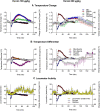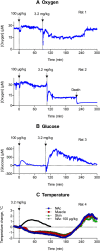Intravenous Heroin Induces Rapid Brain Hypoxia and Hyperglycemia that Precede Brain Metabolic Response
- PMID: 28593192
- PMCID: PMC5461556
- DOI: 10.1523/ENEURO.0151-17.2017
Intravenous Heroin Induces Rapid Brain Hypoxia and Hyperglycemia that Precede Brain Metabolic Response
Abstract
Heroin use and overdose have increased in recent years as people transition from abusing prescription opiates to using the cheaper street drug. Despite a long history of research, many physiological effects of heroin and their underlying mechanisms remain unknown. Here, we used high-speed amperometry to examine the effects of intravenous heroin on oxygen and glucose levels in the nucleus accumbens (NAc) in freely-moving rats. Heroin within the dose range of human drug use and rat self-administration (100-200 μg/kg) induced a rapid, strong, but transient drop in NAc oxygen that was followed by a slower and more prolonged rise in glucose. Using oxygen recordings in the subcutaneous space, a densely-vascularized site with no metabolic activity, we confirmed that heroin-induced brain hypoxia results from decreased blood oxygen, presumably due to drug-induced respiratory depression. Respiratory depression and the associated rise in CO2 levels appear to drive tonic increases in NAc glucose via local vasodilation. Heroin-induced changes in oxygen and glucose were rapid and preceded the slow and prolonged increase in brain temperature and were independent of enhanced intra-brain heat production, an index of metabolic activation. A very high heroin dose (3.2 mg/kg), corresponding to doses used by experienced drug users in overdose conditions, caused strong and prolonged brain hypoxia and hyperglycemia coupled with robust initial hypothermia that preceded an extended hyperthermic response. Our data suggest heroin-induced respiratory depression as a trigger for brain hypoxia, which leads to hyperglycemia, both of which appear independent of subsequent changes in brain temperature and metabolic neural activity.
Keywords: brain temperature; electrochemistry; opioids; rats; respiratory depression; vascular tone.
Figures







Similar articles
-
Central and Peripheral Mechanisms Underlying Physiological and Drug-Induced Fluctuations in Brain Oxygen in Freely-Moving Rats.Front Integr Neurosci. 2018 Oct 2;12:44. doi: 10.3389/fnint.2018.00044. eCollection 2018. Front Integr Neurosci. 2018. PMID: 30333733 Free PMC article. Review.
-
Heroin Contaminated with Fentanyl Dramatically Enhances Brain Hypoxia and Induces Brain Hypothermia.eNeuro. 2017 Oct 30;4(5):ENEURO.0323-17.2017. doi: 10.1523/ENEURO.0323-17.2017. eCollection 2017 Sep-Oct. eNeuro. 2017. PMID: 29085909 Free PMC article.
-
Fentanyl-Induced Brain Hypoxia Triggers Brain Hyperglycemia and Biphasic Changes in Brain Temperature.Neuropsychopharmacology. 2018 Mar;43(4):810-819. doi: 10.1038/npp.2017.181. Epub 2017 Aug 29. Neuropsychopharmacology. 2018. PMID: 28849778 Free PMC article.
-
Brain Hyperglycemia Induced by Heroin: Association with Metabolic Neural Activation.ACS Chem Neurosci. 2017 Feb 15;8(2):265-271. doi: 10.1021/acschemneuro.6b00246. Epub 2016 Oct 18. ACS Chem Neurosci. 2017. PMID: 27736094 Free PMC article.
-
Respiratory depression and brain hypoxia induced by opioid drugs: Morphine, oxycodone, heroin, and fentanyl.Neuropharmacology. 2019 Jun;151:219-226. doi: 10.1016/j.neuropharm.2019.02.008. Epub 2019 Feb 5. Neuropharmacology. 2019. PMID: 30735692 Free PMC article. Review.
Cited by
-
Central and Peripheral Mechanisms Underlying Physiological and Drug-Induced Fluctuations in Brain Oxygen in Freely-Moving Rats.Front Integr Neurosci. 2018 Oct 2;12:44. doi: 10.3389/fnint.2018.00044. eCollection 2018. Front Integr Neurosci. 2018. PMID: 30333733 Free PMC article. Review.
-
Ventilatory Effects of Fentanyl, Heroin, and d-Methamphetamine, Alone and in Mixtures in Male Rats Breathing Normal Air .J Pharmacol Exp Ther. 2024 Jan 17;388(2):244-256. doi: 10.1124/jpet.123.001653. J Pharmacol Exp Ther. 2024. PMID: 37739803 Free PMC article.
-
Oxygen fluctuations in the brain and periphery induced by intravenous fentanyl: effects of dose and drug experience.J Neurophysiol. 2024 Aug 1;132(2):322-334. doi: 10.1152/jn.00177.2024. Epub 2024 Jun 12. J Neurophysiol. 2024. PMID: 38863429 Free PMC article.
-
Dynamics of heroin molecule inside the lipid membrane: a molecular dynamics study.J Mol Model. 2019 Apr 24;25(5):121. doi: 10.1007/s00894-019-4002-y. J Mol Model. 2019. PMID: 31020452
-
Analysis of heroin effects on calcium channels in rat cardiomyocytes based on transcriptomics and metabolomics.Open Med (Wars). 2023 Jul 31;18(1):20230765. doi: 10.1515/med-2023-0765. eCollection 2023. Open Med (Wars). 2023. PMID: 37554148 Free PMC article.
References
Publication types
MeSH terms
Substances
Grants and funding
LinkOut - more resources
Full Text Sources
Other Literature Sources
Medical
